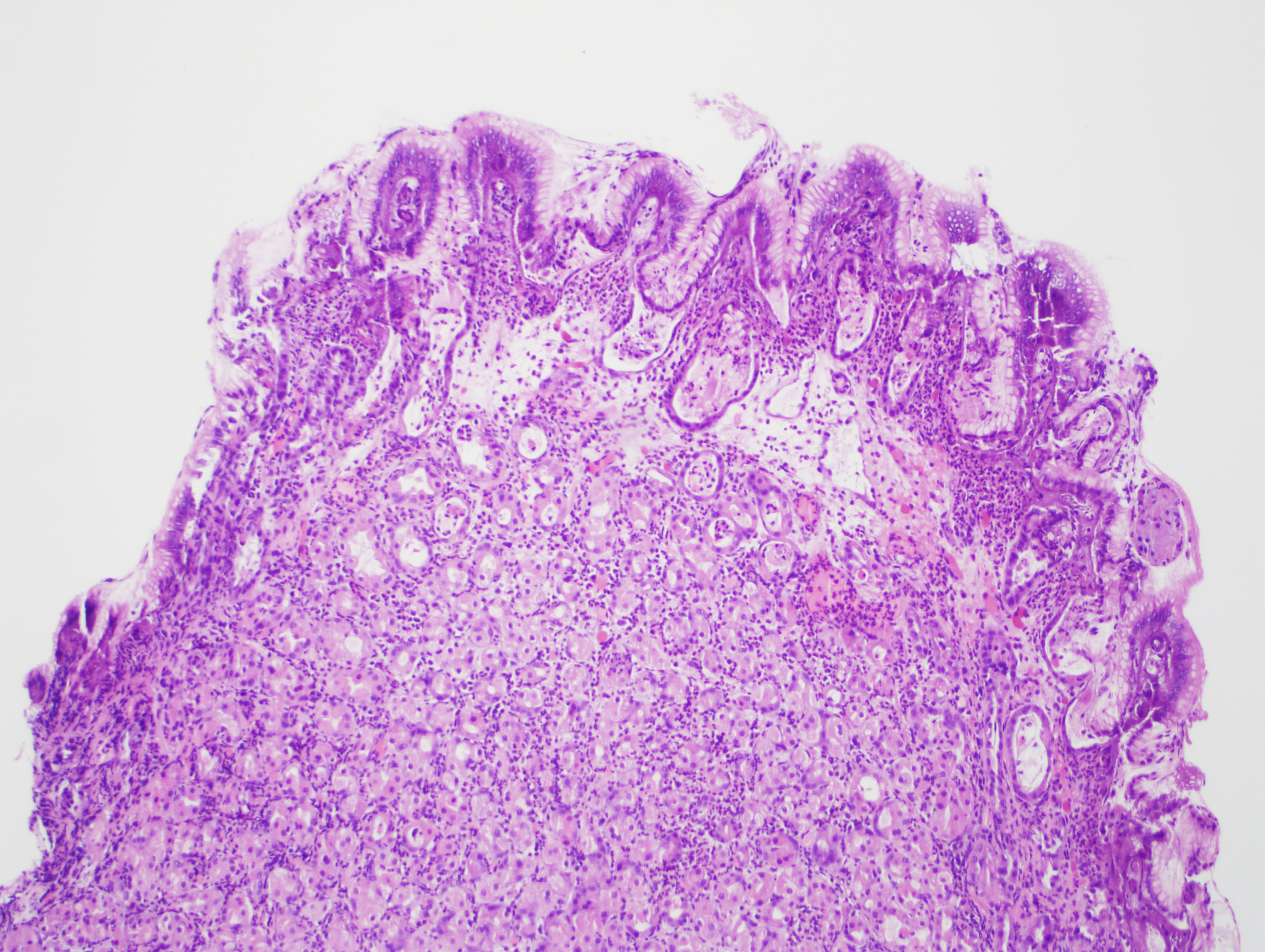Table of Contents
Definition / general | Essential features | Terminology | ICD coding | Epidemiology | Sites | Clinical features | Diagnosis | Prognostic factors | Case reports | Treatment | Gross description | Microscopic (histologic) description | Microscopic (histologic) images | Positive stains | Sample pathology report | Differential diagnosis | Board review style question #1 | Board review style answer #1 | Board review style question #2 | Board review style answer #2Cite this page: Zhang T, Yin F. Doxycycline. PathologyOutlines.com website. https://www.pathologyoutlines.com/topic/stomachdoxycycline.html. Accessed April 18th, 2024.
Definition / general
- Doxycycline, an oral tetracycline antibiotic, has been associated with gastric mucosal injury with characteristic endoscopic and histopathologic features
Essential features
- Patients present with dysphagia, epigastric abdominal pain and retrosternal chest pain
- Endoscopic finding: gastric mucosal erosions, nonbleeding ulcers, gastric mucosa with white plaque-like lesions
- Histopathologic findings: superficial mucosal capillaries with eosinophilic degenerative changes and fibrin microthrombi (Am J Surg Pathol 2013;37:259)
Terminology
- Pill induced gastritis
- Acute erosive gastritis with ulceration
ICD coding
- No official coding established
Epidemiology
- Patients with bacterial infections such as Lyme disease
- Patients in need of prevention of malaria
- Patients with severe acne or rosacea (Am J Surg Pathol 2017;41:374)
Sites
- Stomach (gastric body and fundus > gastric antrum)
- Can also occur in esophagus
Clinical features
- Dysphagia, epigastric abdominal pain and retrosternal chest pain
- The time frame for drug use ranges from 5 days to 4 years
Diagnosis
- Clinical presentation, medication history, endoscopic findings, histopathologic findings
Prognostic factors
- Complete resolution of symptoms following cessation of the medication (Am J Surg Pathol 2017;41:374)
Case reports
- 25 year old woman with odynophagia and epigastric pain (Am J Gastroenterol 1999;94:511)
- 28 year old woman with retrosternal chest pain and odynophagia (Gastroenterology Res 2012;5:236)
- 33 year old woman with retrosternal and epigastric pain and odynophagia (Turk J Gastroenterol 2002;13:232)
- 3 patients with doxycycline treatment for various infections (Hum Pathol 2017;66:212)
Treatment
- Cessation of the medication
Gross description
- Gastric mucosal erosions and nonbleeding ulcers
- Gastric mucosa with white plaque-like lesions
Microscopic (histologic) description
- Superficial mucosal capillaries with eosinophilic degenerative changes (Am J Surg Pathol 2013; 37:259)
- Background gastric mucosa with reactive changes in foveolar epithelium, superficial mucosal necrosis and neutrophilic infiltration within lamina propria
Microscopic (histologic) images
Positive stains
- CD61: highlights fibrin microthrombi (Am J Surg Pathol 2013;37:259)
Sample pathology report
- Stomach, biopsy:
- Gastric oxyntic mucosa with active inflammation, superficial mucosal necrosis and eosinophilic degeneration of superficial capillaries, features most compatible with doxycycline induced gastric mucosal injury
- Negative for intestinal metaplasia or dysplasia
- No morphologic evidence of Helicobacter pylori organisms
Differential diagnosis
- Gastric antral vascular ectasia
- Usually affects the gastric antrum
- No superficial mucosal necrosis or vascular degenerative changes
- Endoscopy: red mucosal stripes radiating into antrum (Am J Surg Pathol 2017;41:374)
- Portal hypertensive gastropathy
- No superficial mucosal necrosis or vascular degenerative changes
- Endoscopy: snakeskin-like mucosal pattern (Am J Surg Pathol 2017;41:374)
- Helicobacter pylori infection
- H. pylori organisms detected
Board review style question #1
A 75 year old female with history of morbid obesity and rheumatoid arthritis presented with abdominal pain and hematemesis. She had periprosthetic infection and was on antibiotics. EGD shows a circumferential ulcer covered with white exudates below the gastroesophageal junction. A representative photomicrograph of the biopsy is shown. Which is the most likely diagnosis?
- Autoimmune atrophic gastritis
- Cytomegalovirus gastritis
- Doxycycline related gastric mucosal injury
- Gastric antral vascular ectasia
- Portal hypertensive gastropathy
Board review style answer #1
C. The biopsy reveals gastric mucosa with superficial capillary vessel wall eosinophilic degeneration, prominent lamina propria neutrophilic infiltration and mild reactive foveolar epithelial changes. Endoscopic findings include a circumferential ulcer covered with white exudates. These findings are most compatible with doxycycline associated gastric mucosal injury.
Comment Here
Reference: Doxycycline
Comment Here
Reference: Doxycycline
Board review style question #2
Which of the following is true about doxycycline related gastric mucosal injury?
- Associated with granuloma formation
- Characteristic findings include perivascular edema and endotheliitis
- Gastric antrum is the most common site of injury
- Snakeskin mucosal pattern on endoscopy
- Superficial mucosal vascular degenerative changes
Board review style answer #2
E. Doxycycline induced gastritis usually causes damage to the gastric body or fundus, and the characteristic histopathologic findings include superficial mucosal necrosis, degenerative changes involving capillary vessel wall and fibrin microthrombi.
Comment Here
Reference: Doxycycline
Comment Here
Reference: Doxycycline







